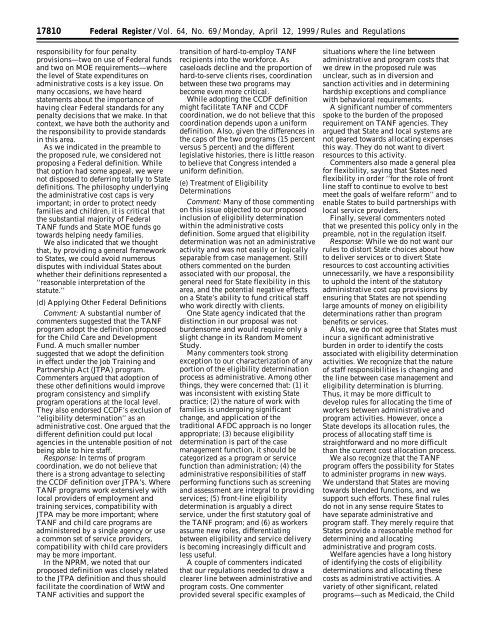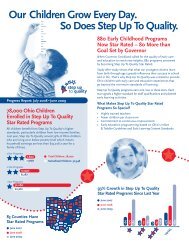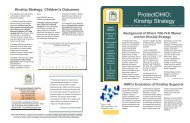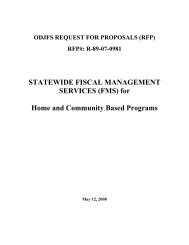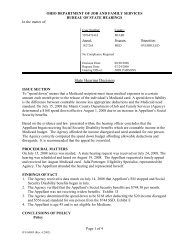Final TANF Rule as published in the Federal Register 4/12/1999
Final TANF Rule as published in the Federal Register 4/12/1999
Final TANF Rule as published in the Federal Register 4/12/1999
Create successful ePaper yourself
Turn your PDF publications into a flip-book with our unique Google optimized e-Paper software.
17810 <strong>Federal</strong> <strong>Register</strong> / Vol. 64, No. 69 / Monday, April <strong>12</strong>, <strong>1999</strong> / <strong>Rule</strong>s and Regulations<br />
responsibility for four penalty<br />
provisions—two on use of <strong>Federal</strong> funds<br />
and two on MOE requirements—where<br />
<strong>the</strong> level of State expenditures on<br />
adm<strong>in</strong>istrative costs is a key issue. On<br />
many occ<strong>as</strong>ions, we have heard<br />
statements about <strong>the</strong> importance of<br />
hav<strong>in</strong>g clear <strong>Federal</strong> standards for any<br />
penalty decisions that we make. In that<br />
context, we have both <strong>the</strong> authority and<br />
<strong>the</strong> responsibility to provide standards<br />
<strong>in</strong> this area.<br />
As we <strong>in</strong>dicated <strong>in</strong> <strong>the</strong> preamble to<br />
<strong>the</strong> proposed rule, we considered not<br />
propos<strong>in</strong>g a <strong>Federal</strong> def<strong>in</strong>ition. While<br />
that option had some appeal, we were<br />
not disposed to deferr<strong>in</strong>g totally to State<br />
def<strong>in</strong>itions. The philosophy underly<strong>in</strong>g<br />
<strong>the</strong> adm<strong>in</strong>istrative cost caps is very<br />
important; <strong>in</strong> order to protect needy<br />
families and children, it is critical that<br />
<strong>the</strong> substantial majority of <strong>Federal</strong><br />
<strong>TANF</strong> funds and State MOE funds go<br />
towards help<strong>in</strong>g needy families.<br />
We also <strong>in</strong>dicated that we thought<br />
that, by provid<strong>in</strong>g a general framework<br />
to States, we could avoid numerous<br />
disputes with <strong>in</strong>dividual States about<br />
whe<strong>the</strong>r <strong>the</strong>ir def<strong>in</strong>itions represented a<br />
‘‘re<strong>as</strong>onable <strong>in</strong>terpretation of <strong>the</strong><br />
statute.’’<br />
(d) Apply<strong>in</strong>g O<strong>the</strong>r <strong>Federal</strong> Def<strong>in</strong>itions<br />
Comment: A substantial number of<br />
commenters suggested that <strong>the</strong> <strong>TANF</strong><br />
program adopt <strong>the</strong> def<strong>in</strong>ition proposed<br />
for <strong>the</strong> Child Care and Development<br />
Fund. A much smaller number<br />
suggested that we adopt <strong>the</strong> def<strong>in</strong>ition<br />
<strong>in</strong> effect under <strong>the</strong> Job Tra<strong>in</strong><strong>in</strong>g and<br />
Partnership Act (JTPA) program.<br />
Commenters argued that adoption of<br />
<strong>the</strong>se o<strong>the</strong>r def<strong>in</strong>itions would improve<br />
program consistency and simplify<br />
program operations at <strong>the</strong> local level.<br />
They also endorsed CCDF’s exclusion of<br />
‘‘eligibility determ<strong>in</strong>ation’’ <strong>as</strong> an<br />
adm<strong>in</strong>istrative cost. One argued that <strong>the</strong><br />
different def<strong>in</strong>ition could put local<br />
agencies <strong>in</strong> <strong>the</strong> untenable position of not<br />
be<strong>in</strong>g able to hire staff.<br />
Response: In terms of program<br />
coord<strong>in</strong>ation, we do not believe that<br />
<strong>the</strong>re is a strong advantage to select<strong>in</strong>g<br />
<strong>the</strong> CCDF def<strong>in</strong>ition over JTPA’s. Where<br />
<strong>TANF</strong> programs work extensively with<br />
local providers of employment and<br />
tra<strong>in</strong><strong>in</strong>g services, compatibility with<br />
JTPA may be more important; where<br />
<strong>TANF</strong> and child care programs are<br />
adm<strong>in</strong>istered by a s<strong>in</strong>gle agency or use<br />
a common set of service providers,<br />
compatibility with child care providers<br />
may be more important.<br />
In <strong>the</strong> NPRM, we noted that our<br />
proposed def<strong>in</strong>ition w<strong>as</strong> closely related<br />
to <strong>the</strong> JTPA def<strong>in</strong>ition and thus should<br />
facilitate <strong>the</strong> coord<strong>in</strong>ation of WtW and<br />
<strong>TANF</strong> activities and support <strong>the</strong><br />
transition of hard-to-employ <strong>TANF</strong><br />
recipients <strong>in</strong>to <strong>the</strong> workforce. As<br />
c<strong>as</strong>eloads decl<strong>in</strong>e and <strong>the</strong> proportion of<br />
hard-to-serve clients rises, coord<strong>in</strong>ation<br />
between <strong>the</strong>se two programs may<br />
become even more critical.<br />
While adopt<strong>in</strong>g <strong>the</strong> CCDF def<strong>in</strong>ition<br />
might facilitate <strong>TANF</strong> and CCDF<br />
coord<strong>in</strong>ation, we do not believe that this<br />
coord<strong>in</strong>ation depends upon a uniform<br />
def<strong>in</strong>ition. Also, given <strong>the</strong> differences <strong>in</strong><br />
<strong>the</strong> caps of <strong>the</strong> two programs (15 percent<br />
versus 5 percent) and <strong>the</strong> different<br />
legislative histories, <strong>the</strong>re is little re<strong>as</strong>on<br />
to believe that Congress <strong>in</strong>tended a<br />
uniform def<strong>in</strong>ition.<br />
(e) Treatment of Eligibility<br />
Determ<strong>in</strong>ations<br />
Comment: Many of those comment<strong>in</strong>g<br />
on this issue objected to our proposed<br />
<strong>in</strong>clusion of eligibility determ<strong>in</strong>ation<br />
with<strong>in</strong> <strong>the</strong> adm<strong>in</strong>istrative costs<br />
def<strong>in</strong>ition. Some argued that eligibility<br />
determ<strong>in</strong>ation w<strong>as</strong> not an adm<strong>in</strong>istrative<br />
activity and w<strong>as</strong> not e<strong>as</strong>ily or logically<br />
separable from c<strong>as</strong>e management. Still<br />
o<strong>the</strong>rs commented on <strong>the</strong> burden<br />
<strong>as</strong>sociated with our proposal, <strong>the</strong><br />
general need for State flexibility <strong>in</strong> this<br />
area, and <strong>the</strong> potential negative effects<br />
on a State’s ability to fund critical staff<br />
who work directly with clients.<br />
One State agency <strong>in</strong>dicated that <strong>the</strong><br />
dist<strong>in</strong>ction <strong>in</strong> our proposal w<strong>as</strong> not<br />
burdensome and would require only a<br />
slight change <strong>in</strong> its Random Moment<br />
Study.<br />
Many commenters took strong<br />
exception to our characterization of any<br />
portion of <strong>the</strong> eligibility determ<strong>in</strong>ation<br />
process <strong>as</strong> adm<strong>in</strong>istrative. Among o<strong>the</strong>r<br />
th<strong>in</strong>gs, <strong>the</strong>y were concerned that: (1) it<br />
w<strong>as</strong> <strong>in</strong>consistent with exist<strong>in</strong>g State<br />
practice; (2) <strong>the</strong> nature of work with<br />
families is undergo<strong>in</strong>g significant<br />
change, and application of <strong>the</strong><br />
traditional AFDC approach is no longer<br />
appropriate; (3) because eligibility<br />
determ<strong>in</strong>ation is part of <strong>the</strong> c<strong>as</strong>e<br />
management function, it should be<br />
categorized <strong>as</strong> a program or service<br />
function than adm<strong>in</strong>istration; (4) <strong>the</strong><br />
adm<strong>in</strong>istrative responsibilities of staff<br />
perform<strong>in</strong>g functions such <strong>as</strong> screen<strong>in</strong>g<br />
and <strong>as</strong>sessment are <strong>in</strong>tegral to provid<strong>in</strong>g<br />
services; (5) front-l<strong>in</strong>e eligibility<br />
determ<strong>in</strong>ation is arguably a direct<br />
service, under <strong>the</strong> first statutory goal of<br />
<strong>the</strong> <strong>TANF</strong> program; and (6) <strong>as</strong> workers<br />
<strong>as</strong>sume new roles, differentiat<strong>in</strong>g<br />
between eligibility and service delivery<br />
is becom<strong>in</strong>g <strong>in</strong>cre<strong>as</strong><strong>in</strong>gly difficult and<br />
less useful.<br />
A couple of commenters <strong>in</strong>dicated<br />
that our regulations needed to draw a<br />
clearer l<strong>in</strong>e between adm<strong>in</strong>istrative and<br />
program costs. One commenter<br />
provided several specific examples of<br />
situations where <strong>the</strong> l<strong>in</strong>e between<br />
adm<strong>in</strong>istrative and program costs that<br />
we drew <strong>in</strong> <strong>the</strong> proposed rule w<strong>as</strong><br />
unclear, such <strong>as</strong> <strong>in</strong> diversion and<br />
sanction activities and <strong>in</strong> determ<strong>in</strong><strong>in</strong>g<br />
hardship exceptions and compliance<br />
with behavioral requirements.<br />
A significant number of commenters<br />
spoke to <strong>the</strong> burden of <strong>the</strong> proposed<br />
requirement on <strong>TANF</strong> agencies. They<br />
argued that State and local systems are<br />
not geared towards allocat<strong>in</strong>g expenses<br />
this way. They do not want to divert<br />
resources to this activity.<br />
Commenters also made a general plea<br />
for flexibility, say<strong>in</strong>g that States need<br />
flexibility <strong>in</strong> order ‘‘for <strong>the</strong> role of front<br />
l<strong>in</strong>e staff to cont<strong>in</strong>ue to evolve to best<br />
meet <strong>the</strong> goals of welfare reform’’ and to<br />
enable States to build partnerships with<br />
local service providers.<br />
<strong>F<strong>in</strong>al</strong>ly, several commenters noted<br />
that we presented this policy only <strong>in</strong> <strong>the</strong><br />
preamble, not <strong>in</strong> <strong>the</strong> regulation itself.<br />
Response: While we do not want our<br />
rules to distort State choices about how<br />
to deliver services or to divert State<br />
resources to cost account<strong>in</strong>g activities<br />
unnecessarily, we have a responsibility<br />
to uphold <strong>the</strong> <strong>in</strong>tent of <strong>the</strong> statutory<br />
adm<strong>in</strong>istrative cost cap provisions by<br />
ensur<strong>in</strong>g that States are not spend<strong>in</strong>g<br />
large amounts of money on eligibility<br />
determ<strong>in</strong>ations ra<strong>the</strong>r than program<br />
benefits or services.<br />
Also, we do not agree that States must<br />
<strong>in</strong>cur a significant adm<strong>in</strong>istrative<br />
burden <strong>in</strong> order to identify <strong>the</strong> costs<br />
<strong>as</strong>sociated with eligibility determ<strong>in</strong>ation<br />
activities. We recognize that <strong>the</strong> nature<br />
of staff responsibilities is chang<strong>in</strong>g and<br />
<strong>the</strong> l<strong>in</strong>e between c<strong>as</strong>e management and<br />
eligibility determ<strong>in</strong>ation is blurr<strong>in</strong>g.<br />
Thus, it may be more difficult to<br />
develop rules for allocat<strong>in</strong>g <strong>the</strong> time of<br />
workers between adm<strong>in</strong>istrative and<br />
program activities. However, once a<br />
State develops its allocation rules, <strong>the</strong><br />
process of allocat<strong>in</strong>g staff time is<br />
straightforward and no more difficult<br />
than <strong>the</strong> current cost allocation process.<br />
We also recognize that <strong>the</strong> <strong>TANF</strong><br />
program offers <strong>the</strong> possibility for States<br />
to adm<strong>in</strong>ister programs <strong>in</strong> new ways.<br />
We understand that States are mov<strong>in</strong>g<br />
towards blended functions, and we<br />
support such efforts. These f<strong>in</strong>al rules<br />
do not <strong>in</strong> any sense require States to<br />
have separate adm<strong>in</strong>istrative and<br />
program staff. They merely require that<br />
States provide a re<strong>as</strong>onable method for<br />
determ<strong>in</strong><strong>in</strong>g and allocat<strong>in</strong>g<br />
adm<strong>in</strong>istrative and program costs.<br />
Welfare agencies have a long history<br />
of identify<strong>in</strong>g <strong>the</strong> costs of eligibility<br />
determ<strong>in</strong>ations and allocat<strong>in</strong>g <strong>the</strong>se<br />
costs <strong>as</strong> adm<strong>in</strong>istrative activities. A<br />
variety of o<strong>the</strong>r significant, related<br />
programs—such <strong>as</strong> Medicaid, <strong>the</strong> Child


